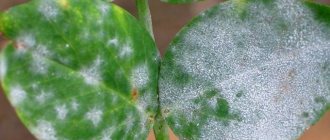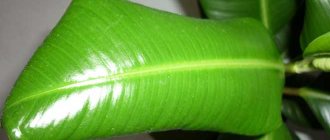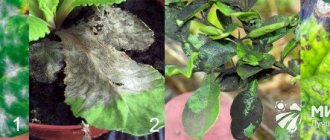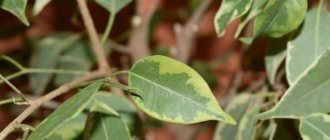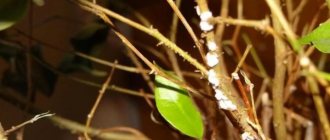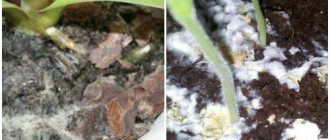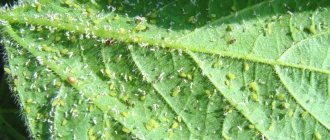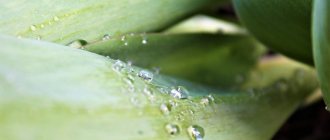Plants » Flowers
0
2726
Article rating
Kira Stoletova
Ficus is especially popular among home decorative bush flowers. Caring for it is quite simple, however, like many flowers, it is susceptible to various diseases. Ficus diseases are quite simple; they are mainly caused by poor living conditions, lack of prevention, or a sick flower in the neighborhood.
Diseases and treatment methods for ficus
Treatment of the bush largely depends on the nature of the disease. In some cases, florists recommend using medicinal rubbing and spraying, but sometimes the plant has to be cut off at the root, since this is the only way to save the flower.
Causes of diseases
Why do ficus trees get sick? Various factors contribute to this, but most often the culprit is improper flower care:
- lack of light and strong temperature fluctuations;
- dry air;
- non-compliance with the irrigation regime: too much water or not enough water;
- lack of mineral feeding or excess fertilizer;
- soil that does not match the type of flower.
If the plant begins to wilt and shed its leaves, you should check the conditions of its maintenance. At first, it is worth changing the location of the pot and reviewing the watering regime.
If after a few days the ficus continues to die, the cause of the ficus disease is pests or fungus. In this case, you need to inspect the leaves and branches for stains or mold. Their presence indicates harmful insects. Depending on the cause of the ficus disease, their treatment also varies.
Fungicide for the treatment of rubber
The fungicide solution helps control pests well. Today there are several biological poisons that help effectively fight ficus diseases:
- Copper-containing (iron sulfate, manganese, potassium). Effective against anthracnose, powdery mildew and a number of pests.
- Organic , based on a number of chemical compounds. Used against fungi. The effectiveness depends on the specific plant and the severity of its damage.
- Biological - fights diseases, rot and insects well.
In specialized stores you can always find the necessary drug to save the plant.
Thus, spots on ficus leaves are an alarm bell. This means that the plant has been attacked by pests, bacteria or fungi . It is urgent to understand what the reason is and begin to act. Untimely control methods can cause the death of the tree.
Foliage diseases
Any ficus disease first appears on the leaves. Leaf diseases have several external manifestations:
Yellowing
Yellowing leaves may be a result of dry indoor air. A similar phenomenon can most often be observed in winter if you place the plant near a battery. The leaves begin to dry and wither, their color turns from green to yellowish. If your ficus loses too much foliage, it will die. To solve this problem, you need to move the pot to another place and spray the leaves with water every few days.
Do not get carried away with rearrangements: ficus prefers stability and can experience stress from frequent changes of place. Nervous shock in plants manifests itself in the same way: the foliage turns yellow and falls off. You should initially select the optimal location of the indoor flower.
Fineness
Small leaf size, poor elasticity and rapid crown fall indicate a lack of mineral components in the soil. Ficus needs proper nutrition. If the foliage of the plant begins to degenerate and fall off, the flower should be transplanted to another soil. The new soil should contain sand, peat and leaf soil. After transplantation, the ficus needs to be watered and not disturbed for a while.
If the leaves turn yellow at the edges and fall off quickly, this indicates increased soil moisture. A strict period of time must be observed between waterings: the soil must have time to dry completely, otherwise the root system may begin to rot.
Reset Sheet
Falling leaves at the bottom of the stem is most often not a sign of disease. This is a natural process associated with the old age of the flower.
If the trunk of the tree is too bare, the ficus will feel uncomfortable in the pot. This plant should be replanted.
Dieback
Crown dieback is usually the first symptom of infestations and harmful insects. In this case, the foliage must be treated with special preparations or a soap solution.
The book will help determine the type of disease
If the ficus leaves begin to die quickly, a thorough examination should be carried out to identify the disease. To make sure the diagnosis is correct, you can use the atlas of plant diseases, which reflects ficus diseases with photographs of lesions.
Why does ficus get sick?
Ficus can get sick due to improper care, namely unfavorable growing conditions:
- the air is insufficiently or excessively humid;
- insufficient lighting and incorrect air temperature;
- excessive watering (if the ficus can tolerate dry soil, then with excess moisture the risk of death is high);
- lack of minerals or excessive fertilization of the soil;
- there is no balance in the soil composition.
Most often, the ficus withers, the leaves turn yellow and fall off. In case of such problems, it is necessary to adjust the care, namely do the following:
- water less or more;
- move the ficus to another place where there is more or, conversely, less sun;
- transplant into a new substrate, etc.
Join our Facebook group
Pests
Rubber ficus pests are living microorganisms and insects that feed on the foliage, sap or roots of the plant. Most often they end up in the pot along with poor-quality soil. Sometimes an infected plant can be accidentally purchased in a store.
Pests pose a great danger to indoor plants because they are easily transmitted from one flower to another. Signs of pest infestation can be expressed in different ways.
Shchitovka
A characteristic sign for this type of pest is raised spots on the inside of the leaves. They occur along the veins and in some cases can affect the rubber trunk and the outer surface of the crown. First of all, the sap of the plant is important for scale insects; they suck it out, leaving behind a sticky secretion. Another parasitic organism, the sooty fungus, also likes to live in such an environment.
To combat scale insects at home, you will need soapy water and the drug Actellik. First you need to treat the foliage with a soap solution, and then disinfect the affected area with the drug.
Mealybug
The disease appears as small pieces of cobwebs on the foliage in which the brown insect lives.
The scale insect feeds on the sap of the plant, slowing down the development of the broadleaf ficus. The pest can also be transmitted by air to other indoor flowers.
Caring for a ficus during infection consists of destroying cobwebs and wiping the leaves with a soap solution. A folk remedy helps against scale insects: water infused with tobacco. Similar procedures should be carried out daily until the flower is completely cured. If the disease has affected most of the plant, it should be sprayed with confidrome.
Spider mite
This pest appears in warm and dry rooms. The mite does not pierce the leaves of the plant, but gnaws through the skin to the pulp and sucks out the liquid. The insect leaves behind brown spots. The mite multiplies very quickly and creates a colony; within a week, the rubber-bearing ficus can be completely covered with cobwebs.
The disease can destroy the flower
Affected foliage quickly dies. There are two types of spider mites: yellow and red.
To get rid of the insect, you should increase the humidity in the room. The leaves of a diseased ficus should be sprayed with water and wiped with soapy water. As a treatment, you can wrap the flower in a thick plastic bag for several days, then treat it with ground sulfur or garlic tincture. To speed up recovery, ficus is sprayed with insecticides.
Trips
Such pests prefer a colonial lifestyle and settle on the inner surface of the leaf. A favorable environment for thrips is a warm room with high humidity. After the insect, brown spots with a dark outline remain on the ficus foliage. The crown of the plant quickly turns yellow and dies. In addition, the pest is a carrier of many infections.
To kill thrips, use a solution of Pyrethrum. The plant is treated twice a day for a week. There are other drugs designed to help in the fight against this insect:
- Aktara;
- Actillic;
- Tanrek.
Aphid
This is one of the most popular pest species worldwide. Aphids are more active in the warm season; in addition, they can infect many plants because they can fly.
Aphids settle in a small colony on the inside of the leaf. Such leaves begin to curl, and then turn yellow and die. To save the plant from aphid invasion, ficus leaves need to be treated with soapy water or Pyrethrum.
Nematodes
A sign of insects settling on a plant are small nodular swellings that appear on the root system. The secretions of nematodes are poisonous to flowers and, by eating the roots, these worms poison the plant itself. The flower begins to fade and lose its foliage. These pests are dangerous because the infected bush is no longer suitable for reproduction. Also, in the initial stages of Rubber Ficus disease, symptoms do not appear.
Various insecticidal preparations will help get rid of nematodes. However, if the disease is already in full swing, it is better to throw away the plant to prevent infection of other indoor flowers.
Fungal infections
The plant may be affected by a fungus
A fungus is a parasitic organism that lives off the resources of a plant. Such a neighbor is dangerous because it can get into the pot along with the soil and remain dormant for a long time. Of all diseases, fungus is the most difficult to predict, but its treatment is faster, and the plant is less injured than from pests. There are several types of fungus that can infect the rubber plant.
Gray rot
This fungus looks like gray mold. The affected area is the leaves and trunk of the plant. If you shake the ficus slightly, the mold comes off the foliage and flies off as fine dust. The affected crown quickly turns black and falls off. Most often, this disease manifests itself in a damp and warm room.
To treat gray rot, cut off all infected parts of the flower. For prevention purposes, you need to ventilate the room, control the quantity and quality of water for irrigation.
Sooty fungus
This parasitic organism prefers the secretions left behind by pests. Sooty fungus is gray-black in color and looks like a coating on the outside of the leaves. If the crown is covered with a white coating and is easily erased, this is a sign of powdery mildew.
Treatment at home consists of treating the foliage with a cloth soaked in a soapy solution. If the disease persists, the infected leaves need to be cut off. The plant itself will help revive the Funkicide solution.
Fungi on the crown
There are several types of fungus that affect ficus leaves:
- Cercospora - black lesions in the form of spots. Over time, the leaves begin to turn yellow and fall off.
- Anthracnose is rust-colored spots along the edges of the leaves. The fungus covers the leaf not only with dots, but also with wet ulcers. Diseased leaves also fall off.
- Botrytis is characterized by a brown lesion that gradually covers the entire leaf. The spots are characterized by a black halo.
In the case of foliar fungus, treatment must be timely. All infected parts of the ficus are carefully trimmed and disinfected with a fungicide. You should also treat the foliage of neighboring plants.
Root rot
This type of fungus appears in soil with high humidity. The plant begins to wither, the crown turns gray. Spots of rot spread across the trunk and roots.
Treatment in this case is impossible. Such a plant is thrown away along with the pot, since even thorough disinfection does not always prevent fungus. The disease can lie dormant in the soil for a long time and become more active if the moisture level in the room is too high.
Watering too frequently can seriously harm your ficus, even if the soil is not infected with fungus. If you constantly flood a plant, a so-called dropsy will form on the flower. These are small plugs on the inner surface of the leaves. This defect cannot be treated and the affected foliage is simply cut off.
Dark spots on ficus leaves, causes of appearance, methods of eliminating the problem
Ficus rubber is considered one of the most common and beloved potted plants around the world. Among various peoples, this plant is a symbol of family, love, prosperity and fertility. Why did they love him so much? And is it easy to grow this evergreen beauty in your apartment?
Damage by spider mites
These small arthropods live and develop in plant tissues and feed on cell sap. The signal for action is small white spots across the entire surface of the leaves and is described by their thin web.
If you find pests, wash the entire crown, stems and trunk with a soapy solution, isolate it from other plants and treat the tree with special targeted preparations: Borneo, Floromite, Kleschevit, Akarin.
Thrips infestation
Small insects lay clutches with eggs inside the leaf blades, and the larvae that emerge from them gnaw through the surface of the plate with powerful jaws. Motley small white spots begin to appear on the surface, and black dots are visible next to the white spots - insect excrement.
It is not easy to get rid of the pests, since these pests have a fast speed and spread throughout indoor plants, so complex and systemic treatment of plants with drugs such as Aktara, Vertimek, Mospilan is important for control.
Treatments are carried out according to the instructions until thrips completely disappear from the apartment.
Reasons for the appearance of dark spots on leaves
There are many reasons for the appearance of various dark spots, and the main ones are:
Prevention
Proper bush care will help minimize the risk of ficus disease. You should adhere to the watering schedule, feed with mineral components and cut off dry leaves and branches on time. The plant also needs to receive the daily norm of light and heat; the air in the room should not stagnate.
To protect the rubber ficus from infection and pests, you need to follow a number of rules:
- The newly acquired flower must be kept in quarantine for some time. Typically, the isolation period is no more than a week. It is better to keep the ficus in a separate room so that the disease is not transmitted through the air. If after a week of quarantine no infectious diseases have been identified, the plant can be placed next to others.
- It is advisable to inspect flowers every day. Particular attention should be paid to the lower part of the stem and the inner surface of the leaves.
- Every month, ficus foliage should be treated with soapy water. This procedure is vital for bushes located on open loggias or growing outdoors.
